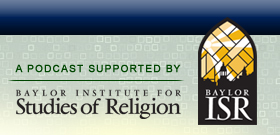

|
David Smith on Episodic Religious Persecutions  Date: February 9th, 2014
 Join us on our Facebook Fan Page for regular updates. Although the United States is often viewed as a beacon for religious freedom around the world, thanks in large part to the institutionalization of the First Amendment, the practice of religious toleration has often fallen well short of the ideals set for itself. Prof. David Smith, lecturer in the Department of Government & International Relations and a faculty member at the United States Studies Center at the University of Sydney (Australia), discusses his explanation for episodic religious persecution in the United States. Using the Latter Day Saints in the 19th century and Jehovah’s Witnesses in the early 20th century as comparative case studies, he argues that religious minorities that are seen as threats to the established political order will quickly find themselves victims of state-sanctioned persecution. We begin the discussion with Prof. Smith’s personal journey to this topic. For an Australian studying American politics, a field dominated by quantitative studies of contemporary political behavior, the choice of such a historical topic seems a bit unique. Nonetheless, David points out how the eyes of a foreigner can often uncover interesting behavioral patterns that often go unnoticed by natives. This leads us to a discussion of how “mythic ideals” within a nation often do not match with historical practice, particularly given that human beings are quite fallible when it comes to reaching noble goals. David then jumps into a detailed elaboration of the persecuted path of the Church of Jesus Christ of Latter-Day Saints (i.e., Mormons) in the 19th century, from their early days in New York and Ohio, through an “extermination order” in Missouri, to the mob execution of their leader Joseph Smith, and finally through their travails into Utah territory and the struggles to become a state. Along the way, David drops hints at his explanation to come, including how the presence of the Mormons in different areas affected the political calculus among existing elites. David places the debates over polygamy and political partisanship into a context of broader struggles for political power that were affecting the nation in the pre- and post-Civil War era. We learn some interesting things about how Harriet Beecher Stowe, famed feminist crusader, changed her position on whether or not Mormon women should be given the right to vote, and how Reed Smoot (half of the infamous Smoot-Hawley tariff act) was prevented from taking his seat in the US Senate because of ongoing concerns over polygamy. We then jump into the early 20th century to discuss the rise of the Jehovah’s Witnesses, a seemingly innocuous group of Christians who refused to salute the flag or have their children recite the Pledge of Allegiance in school. Such actions, combined with their visible proselytizing presence, provoked a number of local organizations such as the American Legion to consider them a serious threat to American nationalism. Combined with concern over the balance of political power at the local level and their stand against military service at a time war was on the horizon, a rash of physical harassment of Witnesses arose in the late 1930s and early 1940s, dissipating around 1941/42 when roughly half of the Witnesses young male missionaries were jailed. We further discuss the reasons why the Witnesses were targetted, but not groups such as the Mennonites and Amish, another religious group that resisted military service and spoke German! Prof. Smith shows how both of these instances of religious persecution were theoretically linked by how each group — Mormons and Witnesses — were perceived as a political threat to the existing state power structure. We then discuss how his explanation played out in other historic instances of religious persecution (or lack thereof) including Catholics, Jews, and the Nation of Islam (a homegrown Muslim group). Interestingly, while the Nation of Islam was facing persecution (around the time of the Witnesses), political authorities were encouraging Muslim immigration from overseas. We also explore why Muslims over the past decade and a half (since September 11, 2001) have not seen the levels of persecution or harassment experienced by the Mormons and Witnesses. David closes with some thoughts on how future persecutions might be contained. Recorded: January 7, 2014. RELATED LINKS David Smith’s bio at the Department of Government & International Relations at the University of Sydney. United States Studies Centre at the University of Sydney. RELATED PODCASTS Patrick Mason on Anti-Mormonism and Mitt Romney. Lynita Newswander on Mormons in America. Jason Jewell on Locke and Religious Toleration. Mark Koyama on Jewish Expulsions. Anthony Gill on Religion and Religious Liberty (An EconTalk simul-podcast). Anthony Gill on the Political Origins of Religious Liberty. Michael McBride on Religious Free-Riding and Mormons. Carmel Chiswick on the Economics of American Judaism.
2 Responses to “David Smith on Episodic Religious Persecutions” |
 Search The Podcast
To search the podcast, type a term and click the Search button.
  Browse Podcast Categories
Select a category below to browse the podcast:
   |















[…] David Smith on Episodic Religious Persecutions. […]
[…] David Smith on Episodic Religious Persecutions. […]